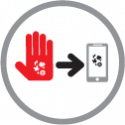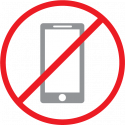How Much Bacteria is on Your Phone?
Cell phones have become a near-constant accessory in recent years. People take their phones everywhere — to dinner, to bed, and even to the bathroom. In fact, Americans check their phones around every 12 minutes. Since people bring their cell phones with them everywhere and touch them often, these devices can turn into breeding grounds for bacteria. A recent study found that there is an average of 17,000 bacterial gene copies on a single cell phone.

Americans check their
phones every 12 minutes.

A single cell phone
can house 17,000
bacterial gene copies.

10X
Percentage times more bacteria
housed on a cell phone than a toilet seat.
What Your Hands Touch, Your Phone Collects
Often, people bring their phones to many bacteria-prone places, including the bathroom and the kitchen. They are also utilizing these devices everywhere, increasing the risk of transferring germs from one area to another, also known as cross-contamination. In foodservice, this presents a public safety risk.

Though microbes are everywhere, not all are negative or dangerous. Normally, bacteria are transferred onto cell phones from cheeks and ears as well as naturally-occurring oils in fingers. While many types of bacteria are nothing to worry about, there are some harmful pathogens that may be passed onto the surface of a cell phone from coughing on the phone or from touching a phone with contaminated hands.

- Streptococcus;
- MRSA;
- coli;
- Coliforms;
- Coagulase Negative Staphylococci (CoNS);
- Mold;
- And yeast including various subspecies/genera of Candida.

Warm Environments Are Perfect Breeding Grounds

40 ℉ – 140 ℉
Bacteria grows rapidly between these temperatures
Our Phones Can Make Us Sick

This is extremely important to note, especially for those working in the foodservice industry, because they are responsible for the health of their patrons as well as the cleanliness of their restaurant. It is common for kitchen teams to use their phones for daily tasks, such as setting timers, listening to music, or researching recipes — but this also means that their phones could be leading to cross-contamination of hands, which in turn contaminate food.
What to Do About it
Every restaurant should have a clear mobile phone policy in the kitchen. If phone use is tolerated, cell phones should be included in and subjected to the same daily cleaning and sanitation standards as other kitchen equipment. The proper use of cleaners and disinfectants is of the utmost importance. This can help lessen the spread of different bacteria in both commercial and home environments. Be sure to follow manufacturers’ guidelines when cleaning electronic devices.
It's also important to note that there are different levels of cleaning:
- Cleaning, which removes visible soil and debris from surfaces;
- Sanitizing, which reduces the presence of any bacteria, viruses, and fungi from surfaces;
- And disinfecting, which eliminates pathogens and disease-causing microorganisms.
Hand Hygiene and Sanitation
Washing your hands is essential for proper hygiene and sanitation. Keeping your hands clean is especially important during the cold and flu season, a time when germs spread rapidly and easily. The FDA recommends washing hands during key times like:
- Before, during, and after food preparation;
- Before eating;
- Before and after caring for a sick person;
- Before and after treating a cut;
- After using the restroom;
- After changing diapers or cleaning up a child;
- After blowing noses, coughing, or sneezing;
- After touching an animal;
- After touching garbage.
If there is no soap, the CDC also recommends using an alcohol-based hand sanitizer. While there is a difference between washing hands and sanitizing them, both can kill pathogens and bacteria.

Restricted Use of Cell Phones in Certain Areas
Since a cell phone can harbor many germs, pathogens, and bacteria on its surface, it is important to restrict the use of cell phones in certain areas. These places include:
- Kitchens, both commercial and residential;
- Bathrooms;
- Dining tables;
- Doctor’s offices;
- And any other places where bacterial exposure could be detrimental to a person’s health.

Restricted use of cell phones
in certain areas.
Instead of using cell phones in these places, make sure to put them somewhere safe and tucked away, and be sure to clean and disinfect your phone often.
Cell phones can spread a variety of germs quickly and easily; however, by utilizing cleaning tools and sticking to a cleaning and disinfecting schedule, people can reduce the chance for cross-contamination and slow the spread of dangerous diseases.

